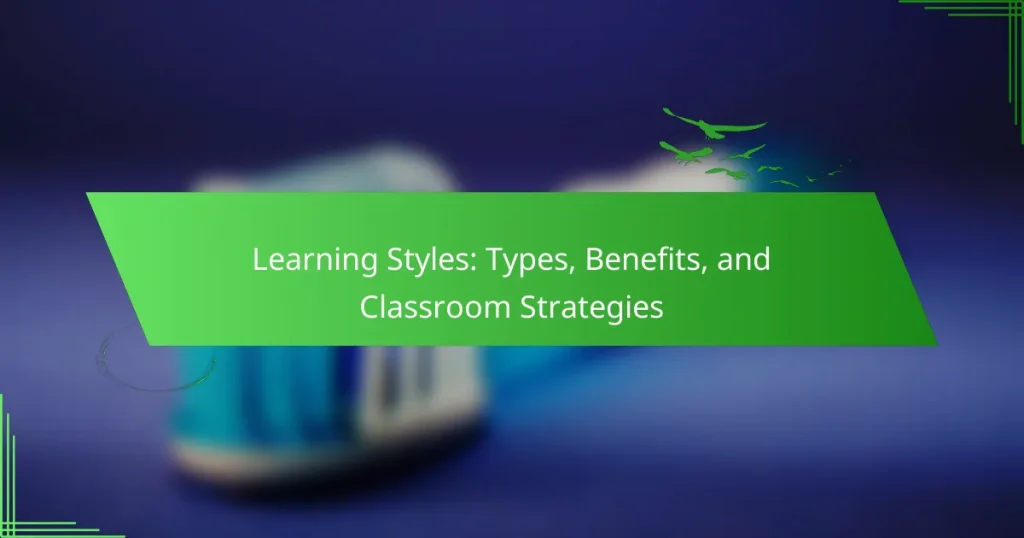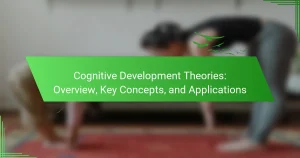Understanding learning styles is crucial for enhancing student engagement and retention in the classroom. This article explores the four primary types: visual, auditory, reading/writing, and kinesthetic. It discusses the benefits of recognizing these styles, effective classroom strategies to accommodate diverse learners, and common mistakes educators should avoid. Additionally, expert insights highlight how tailored approaches can lead to improved academic outcomes.
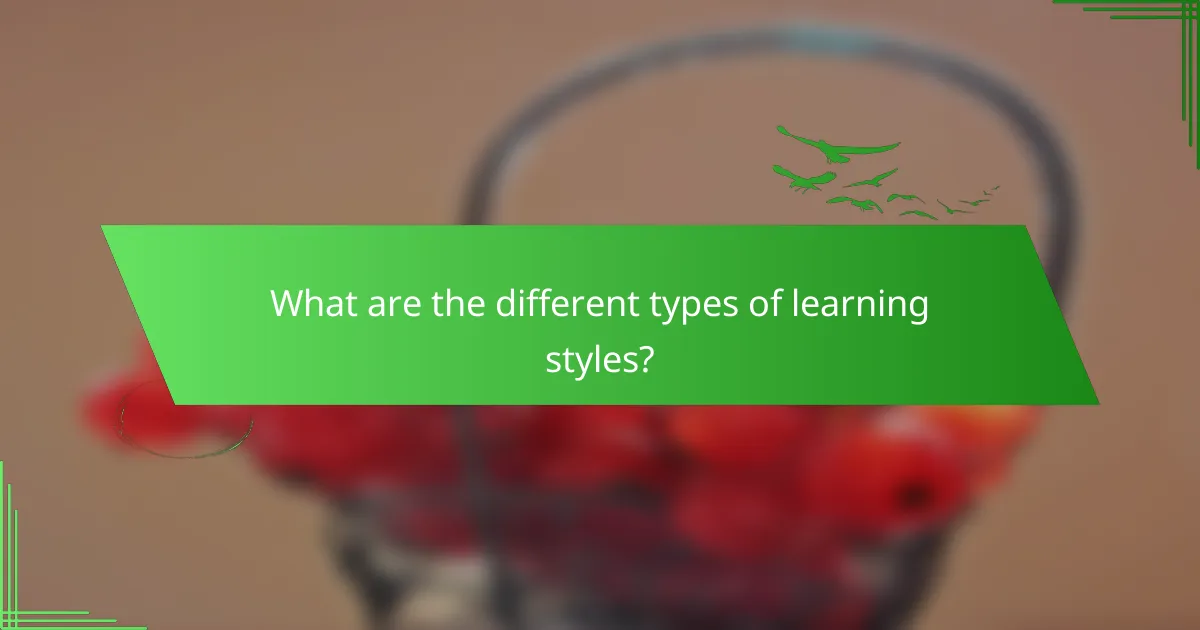
What are the different types of learning styles?
There are four primary types of learning styles: visual, auditory, reading/writing, and kinesthetic. Each style has unique characteristics that influence how individuals absorb and process information.
Visual learners benefit from diagrams, charts, and imagery. Auditory learners thrive on discussions, lectures, and audio materials. Reading/writing learners prefer written text and note-taking. Kinesthetic learners engage best through hands-on activities and physical movement.
Understanding these styles enables educators to tailor their teaching strategies, enhancing student engagement and retention. For example, incorporating multimedia for visual learners can significantly improve comprehension.
How do visual learners absorb information?
Visual learners absorb information primarily through images, diagrams, and visual aids. They benefit from seeing concepts represented graphically, which enhances understanding and retention. For example, using charts and infographics helps them grasp complex ideas more effectively. Engaging with visual materials allows these learners to connect information with visual experiences, improving their overall learning outcomes.
What characteristics define auditory learners?
Auditory learners primarily process information through listening. They excel in environments where verbal communication is emphasized, such as lectures and discussions. Key characteristics include a preference for spoken instructions, strong listening skills, and the ability to recall information better when it is presented audibly. These learners often benefit from strategies like group discussions, audiobooks, and verbal storytelling.
What traits are associated with kinesthetic learners?
Kinesthetic learners are characterized by their preference for hands-on activities and physical engagement in the learning process. They often excel in environments that allow movement and tactile experiences. Common traits include strong motor memory, preference for role-playing or simulations, and difficulty sitting still for long periods. These learners often benefit from interactive lessons that incorporate physical activities, such as experiments or building models.
How do reading/writing learners process information?
Reading/writing learners process information by engaging with text through reading and writing activities. They benefit from written materials and often prefer to take notes, summarize, and create outlines. This style enhances comprehension and retention by allowing learners to interact with content in a structured manner. Strategies for supporting these learners include providing ample reading materials, encouraging journaling, and integrating written assignments into lessons. These approaches foster a deeper understanding of concepts through active engagement with the text.

What are the universal benefits of understanding learning styles?
Understanding learning styles enhances educational outcomes by tailoring approaches to individual needs. Recognizing diverse learning preferences fosters engagement, improves retention, and boosts motivation. For example, visual learners benefit from diagrams, while auditory learners thrive with discussions. This adaptability creates inclusive environments, promoting overall academic success.
How does recognizing learning styles enhance student engagement?
Recognizing learning styles enhances student engagement by tailoring teaching methods to individual preferences. This personalization increases motivation and retention, making lessons more relevant and effective. For instance, visual learners benefit from diagrams, while auditory learners thrive on discussions. By addressing diverse learning styles, educators create inclusive environments that foster active participation and deeper understanding.
What impact do learning styles have on academic performance?
Learning styles significantly influence academic performance by tailoring teaching methods to individual preferences. For example, visual learners may excel with diagrams, while auditory learners benefit from lectures. Adapting classroom strategies to these styles enhances engagement and retention, ultimately improving grades. Research indicates that personalized approaches can lead to a 20% increase in student performance. Understanding and implementing learning styles fosters a more effective educational environment.
How can learning styles improve retention of information?
Learning styles can significantly enhance information retention by catering to individual preferences. Visual learners benefit from diagrams, while auditory learners thrive on discussions. Kinesthetic learners retain information better through hands-on activities. Tailoring teaching methods to these styles fosters engagement and improves memory recall. Research indicates that using varied instructional strategies can increase retention rates by up to 30%.
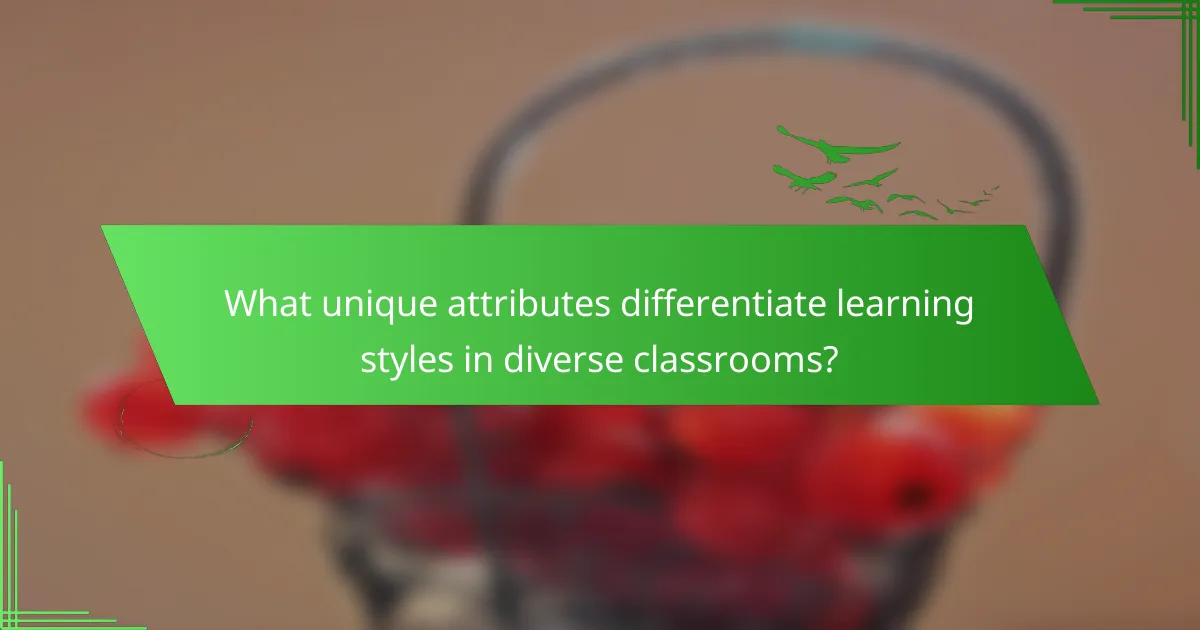
What unique attributes differentiate learning styles in diverse classrooms?
Unique attributes that differentiate learning styles in diverse classrooms include sensory preferences, cognitive processing styles, and motivation factors. Sensory preferences, such as visual, auditory, or kinesthetic learning, influence how students absorb information. Cognitive processing styles, like analytical versus holistic thinking, shape problem-solving approaches. Motivation factors, including intrinsic and extrinsic motivators, affect engagement levels. Understanding these unique attributes enables educators to tailor strategies that enhance learning outcomes for all students.
How do cultural backgrounds influence learning preferences?
Cultural backgrounds significantly shape learning preferences by influencing how individuals process information. For instance, collectivist cultures may prefer collaborative learning, while individualistic cultures often favor independent study. Understanding these differences helps educators tailor strategies to enhance engagement and effectiveness in diverse classrooms.
What role does technology play in accommodating different learning styles?
Technology plays a crucial role in accommodating different learning styles by providing personalized learning experiences. It enables diverse methods of content delivery, such as videos, interactive simulations, and gamified learning, catering to visual, auditory, and kinesthetic learners. For example, adaptive learning platforms assess individual progress and adjust content accordingly, enhancing engagement and comprehension. Additionally, technology facilitates collaboration through online tools, supporting social learners who thrive in group settings. Overall, technology’s versatility makes it an essential tool for addressing varied educational needs and optimizing learning outcomes.

What are the rare attributes of learning styles?
The rare attributes of learning styles include individual sensory preferences, emotional engagement levels, and cultural influences on learning. These unique traits can significantly affect how students absorb and process information, leading to varied educational outcomes. Understanding these rare attributes allows educators to tailor their approaches for diverse learners.
How do emotional factors affect learning style preferences?
Emotional factors significantly influence learning style preferences by shaping motivation and engagement. For instance, students with positive emotional experiences are more likely to adopt active learning styles. Conversely, negative emotions can lead to avoidance of certain learning methods. Understanding these connections helps educators tailor strategies that align with individual emotional states, enhancing overall learning outcomes.
What is the impact of age on learning style adaptation?
Age significantly influences learning style adaptation, as younger learners often favor interactive and experiential methods while older individuals may prefer structured approaches. Research indicates that cognitive development stages affect preferences, with younger students thriving in collaborative environments and older learners benefiting from independent study. Adapting instructional strategies to these age-related preferences enhances engagement and retention. For instance, incorporating technology and hands-on activities can cater to younger audiences, whereas providing detailed resources and self-paced learning options may better suit older students. Understanding these dynamics allows educators to create more effective learning experiences tailored to age-specific needs.
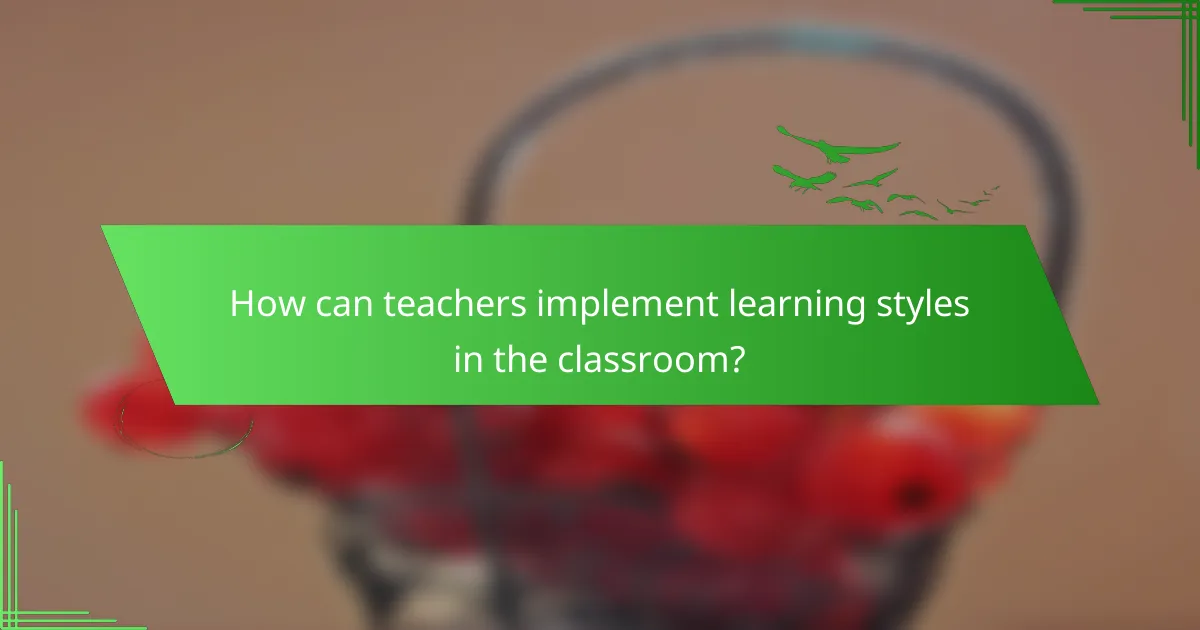
How can teachers implement learning styles in the classroom?
Teachers can implement learning styles in the classroom by tailoring their instructional methods to accommodate diverse preferences. Strategies include using visual aids for visual learners, incorporating group discussions for auditory learners, and providing hands-on activities for kinesthetic learners.
Understanding these styles enhances engagement and retention. For example, visual learners benefit from diagrams, while kinesthetic learners thrive with interactive tasks. Adapting lessons to these preferences fosters a more inclusive environment, ultimately improving student outcomes.
What strategies can be used to identify students’ learning styles?
Identifying students’ learning styles can be achieved through various strategies. Observations, surveys, and assessments are effective methods. Teachers can use questionnaires to gather insights on preferences, such as visual, auditory, or kinesthetic learning. Additionally, analyzing student performance on different tasks can reveal their strengths. Engaging in one-on-one discussions allows for a deeper understanding of individual learning preferences. Implementing these strategies can enhance personalized learning experiences in the classroom.
What assessment tools are effective for determining learning styles?
Effective assessment tools for determining learning styles include the VARK questionnaire, the Multiple Intelligences Inventory, and the Learning Style Inventory. These tools identify individual preferences in learning modalities, such as visual, auditory, reading/writing, and kinesthetic styles. Using these assessments helps tailor educational strategies to enhance student engagement and retention.
How can lesson plans be tailored to different learning styles?
Lesson plans can be tailored to different learning styles by incorporating varied instructional strategies. For visual learners, use diagrams and videos; for auditory learners, integrate discussions and podcasts; for kinesthetic learners, include hands-on activities. Adapting lessons enhances engagement and retention across diverse student needs.
What are examples of activities for visual learners?
Visual learners benefit from activities that engage their sight and help them process information visually. Examples include creating mind maps, using flashcards with images, watching educational videos, participating in visual demonstrations, drawing diagrams, and engaging in art projects related to the subject matter. These activities enhance understanding and retention for visual learners.
What auditory strategies can be integrated into lessons?
Auditory strategies enhance lessons by integrating sound-based learning techniques. These include using music to set the tone, incorporating discussions to foster engagement, and employing audio recordings for diverse perspectives. Such strategies cater to auditory learners, improving retention and understanding.
How can kinesthetic learning be facilitated in a classroom setting?
Kinesthetic learning can be facilitated by incorporating hands-on activities and movement into lessons. Strategies include using manipulatives, role-playing, and interactive projects. These methods engage students physically, enhancing retention and understanding. For example, science experiments allow students to explore concepts actively, while group activities promote collaboration. Creating a classroom environment that encourages movement supports kinesthetic learners effectively.
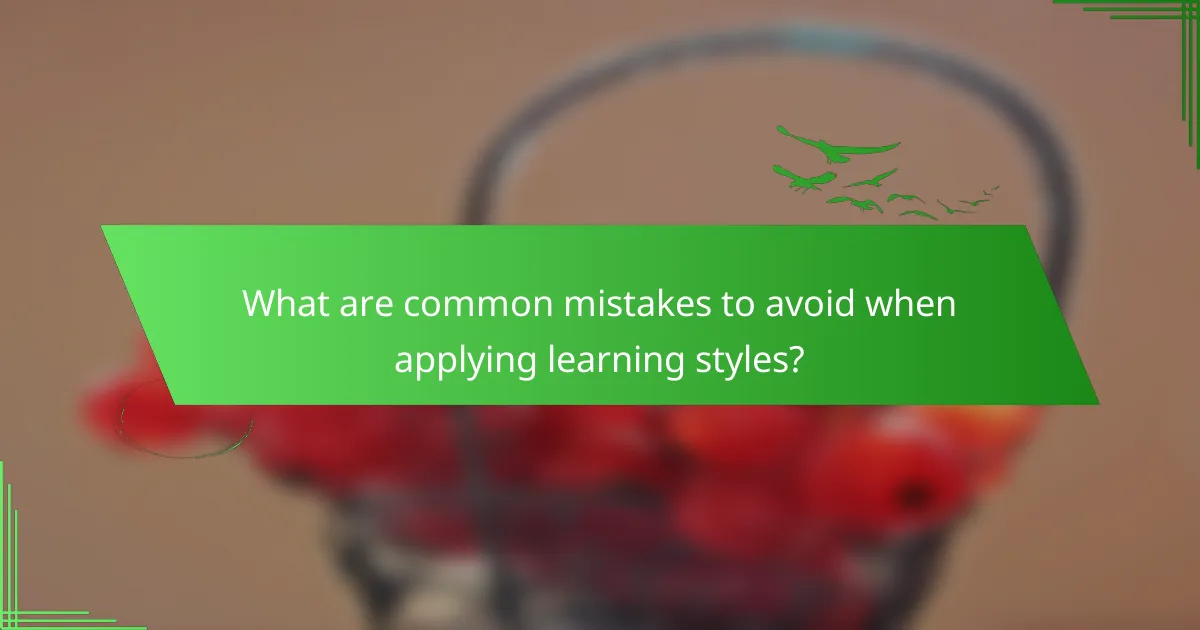
What are common mistakes to avoid when applying learning styles?
Common mistakes to avoid when applying learning styles include overgeneralizing learning preferences, neglecting individual differences, and failing to adapt teaching methods. Many educators mistakenly assume that students learn best exclusively through their preferred style, ignoring the benefits of a multimodal approach. Additionally, not assessing students’ actual needs can lead to ineffective strategies. Finally, relying solely on learning styles without integrating other pedagogical methods limits the potential for effective learning outcomes.
How can oversimplification of learning styles hinder educational outcomes?
Oversimplification of learning styles can lead to ineffective teaching methods. It limits educators’ ability to address diverse student needs, resulting in disengagement and poor academic performance. Research shows that rigid adherence to specific styles neglects the complexity of learning processes. This can diminish critical thinking and adaptability in students.
What are the pitfalls of rigidly categorizing students by learning styles?
Rigidly categorizing students by learning styles can lead to misconceptions and limit their potential. It may create a fixed mindset, discouraging students from exploring diverse learning methods. This approach often overlooks the unique attributes of individual learners, such as their adaptability and varied interests. Additionally, it can result in ineffective teaching strategies that fail to meet the needs of all students, ultimately hindering their academic growth.

What expert insights can enhance the application of learning styles?
Expert insights can significantly enhance the application of learning styles by tailoring educational experiences to individual preferences. Understanding the diverse types of learning styles, such as visual, auditory, and kinesthetic, allows educators to implement targeted strategies. For instance, incorporating multimedia resources can benefit visual learners, while group discussions may enhance auditory comprehension. Additionally, recognizing the unique attributes of each learner enables personalized feedback, fostering a supportive environment. Research indicates that adapting teaching methods to align with learning styles can improve engagement and retention, ultimately leading to better academic outcomes.
How can ongoing professional development support effective learning style integration?
Ongoing professional development enhances effective learning style integration by equipping educators with diverse strategies. This training fosters adaptability, enabling teachers to tailor instruction to various learning preferences. As a result, students experience improved engagement and retention. Continuous learning also promotes collaboration among educators, sharing best practices and innovative techniques. Ultimately, this leads to a more inclusive classroom environment that addresses individual student needs.
What collaborative approaches can be taken to address diverse learning needs?
Collaborative approaches to address diverse learning needs include differentiated instruction, co-teaching models, and peer tutoring. These strategies promote inclusivity and enhance engagement among students with varying abilities. Differentiated instruction tailors learning experiences to individual needs, while co-teaching allows educators to share expertise and support diverse learners simultaneously. Peer tutoring fosters collaboration and reinforces knowledge among students. These methods collectively improve learning outcomes by accommodating various learning styles and preferences.
